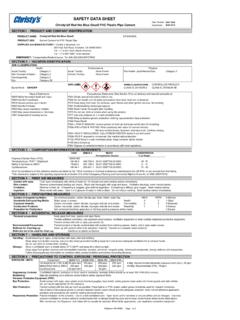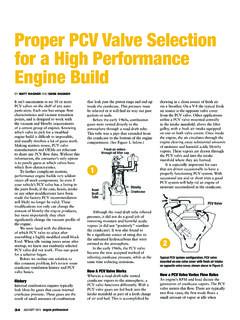Transcription of Guide to Solvent Welding PVC Pipe and Fittings - Christy's
1 Guide to Solvent Welding PVC pipe and FittingsPreferred by Professionals for Over 35 Years For over 35 years, professional contractors have relied on Christy s products to make strong and permanent joints for PVC pressure and drainage lines. This Guide is intended to assist you in learning the techniques and technical requirements needed for joining plastic pipe and recommendations presented here are based on the knowledge and experience of Christy s team of chemists, technical experts and field support personnel. It is recommended that you carefully observe and respect job site conditions as they have a significant impact on the quality and reliability of plastic pipe s offers hands-on training of proper joining techniques. Users that need to expand their familiarity with best practices are encouraged to contact us to arrange individualized s Solvent cements offers solutions for virtually every application providing the distributor and contractor one stop shopping in a single proven brand.
2 Our technical brochures can Guide you toward selecting the right products and formulations for your s Solvent cement and primers are manufactured in a dedicated facility using state-of-the-art equipment and sophisticated process controls. The company s on-site testing laboratories maintain stringent quality standards using multiple test procedures. These ensure the absolute consistency and performance required to meet ASTM, NSF and UPC standards noted for each joints are easy to make and permanent if one follows basic rules, namely: the pipe must be cut square, clean, and sufficient Solvent cement must be applied; assembly must be made while the joining surfaces are still wet; and the joint must be left to cure for a period of time before movement. Obviously, this is an over-simplification of the Solvent cement procedure, but easy to remember because failed PVC joints do so for the following reasons: Insufficient Solvent cement applied to both surfaces.
3 Solvent cement applied to only one surface. The Solvent cement has partially dried or is completely dried prior to assembly of the joint. Using a partially jelled or stringy cement which cannot bite into the pipe or fitting . Cementing surfaces were not properly prepared prior to applying the Solvent cement (dirty, etc.) Improper Solvent cement type was used. Excessive tolerances (gap) between pipe and fitting that cannot be filled by the Solvent cement being used. Piping not properly bottomed out: either a dry joint or not cut square. The joint has been disturbed and the bond broken prior to a firm set. Climate conditions: temperature and humidity greatly impact creation of proper Leaky joints will invariably show shiny spots that could create leak channels from the socket bottom to the outer edge of the joint.
4 A properly made joint will always have a dull satin-like finish. Removal of the shine shows that active Solvent has attacked the surfaces, allowing chemical fusion to take procedures described here will make strong, pressure-tight joints in the shop or in the field. However, it is the knowledge of the operator/installer performing the Solvent cementing function that is of critical importance for a successful job. These procedures are general in nature, and may vary among different manufacturers; however, these procedures apply to both pressure and non-pressure applications and apply only to PVC (polyvinyl chloride) as described in Specification D 2855. Plastic pipe and Fittings are manufactured within certain predetermined tolerances to provide for small variations in the manufacturing read the cautions and warnings as described on each container.
5 Solvent cements are highly flammable, can cause severe irritation to the eyes, lungs, and skin if not properly handled and used in a well ventilated area. Solvent cements are classified as hazardous materials by various government cements are considered unstable for use if there is an appreciable change in viscosity; if they become jellied or string-like, they should be discarded. Do not mix Solvent cements. Solvent cements cannot be reactivated with primers or other solvents . Do not certain you have the proper Solvent cement for the job. Available today are regular, medium and heavy body Solvent cements each with an intended function. There are also clear and different pigmented Solvent cements available, as well as specialty Solvent cements. The regular body grades are usually near-water-thin and intended for small diameter PVC piping inch, inch, and 1 inch.
6 The viscosity can be determined by shaking the can. Sound and feel help indicate the viscosity. Great care must be exercised when using a regular body Solvent cement because the viscosity is such that it has a tendency to run and leave very little on the piping. Climatic variables can also make the Solvent evaporate more quickly. An excellent test for any Solvent cement is to apply a small amount to the piping, allow it to penetrate for up to one minute, and then scrape it with a knife to determine the mil penetration of the Solvent . Shaking the closed container can also tell you a lot. If the Solvent cement sounds and feels like water, a water-thin cement is typically good for small-diameter applications. Additionally, shaking the can will help determine if the cement is still liquid or if it has started to set or gel in the not in use, store solvents and primers in a cool, dry storage area, out of direct sunlight.
7 When storing an opened container, make certain the lid is firmly secured and sealed by turning the can upside down to observe if it leaks. Screw-top containers are not considered to be airtight and have a limited shelf (continued)Working With Solvent cementS Preparation - Assemble the proper materials for the job: primer, Solvent cement, and applicators necessary for the pipe sizes being assembled. Solvent cementing is a fast procedure because you must put together wet joints with speed. An individual joint should be put together in less than one minute on the smaller diameters of PVC piping. Therefore, make certain you have everything necessary to do the job rags, knife, saw, sandpaper, applicator, pipe , Fittings , file, so that the task at hand can be accomplished quickly, with precision, and in a timely must be cut as square as possible.
8 The bottom 1/3 of fitting is the strongest part of the joint , so if you have a crooked cut, pipe will not bottom properly. Use a pipe cutter, power saw, miter box and saw or hand 1 CUTR emove all internal and external burrs, shavings and raised beads with a file or deburring tool. On outside of pipe use a file or beveling tool to produce a 3/32", 10-15 degree chamfer. Burrs and unbeveled pipe can scrape channels into softened Fittings resulting in 2 DEBURRWipe with a clean and dry rag. Moisture will extend cure time and dirt or grease can prevent proper, leak free 3 CLEANC heck pipe and fitting for proper dry fit before cementing. For a good interference fit, the pipe should easily slip into the fitting 1/3 to 2/3 of the way. Too tight of a fit is not acceptable because the pipe may not be able to bottom into fitting during assembly.
9 If the pipe bottoms in the fitting with no interference but not loose, a satisfactory joint can be made provided the pipe and fitting are not out of round. To see if a fitting is acceptable for bonding, hold a short piece of the pipe in a vertical position and insert the fitting on the end. If the fitting falls out of the pipe , do not assemble. Call your pipe and fitting supplier. All pipe and Fittings must conform to ASTM or other recognized standards. A handy way to insure that the pipe fully bottoms into the fitting when making the final Solvent connection is to mark the pipe . To do this, measure depth of fitting socket and make a line on the outside of pipe representing the proper fit. Put a second mark an inch or two above this mark as a reference as the primer and cement could remove or cover the first 4 DRy FITS olvent cementing With A Primer Use the proper size applicator (dauber, swab, roller or brush) for the size of pipe and Fittings being joined.
10 The applicator size should be at least 1/2 the diameter of the pipe . If too small an applicator is used, a sufficient amount of cement cannot be applied. Christy s offers a wide selection of applicators and empty cans to help you achieve best results. Do not assume the applicator provided with the can is automatically the correct size for your pipe diameter.(Special note: complete steps - within 0 seconds to assure a secure joint)A primer is used to penetrate and soften the surfaces of the pipe and Fittings so that they can be fused together. To check the penetration or softening properties of the primer before installation begins, take a small piece of scrap pipe and aggressively apply the primer. While still wet, use a knife or other sharp object and drag across the primed surface.












